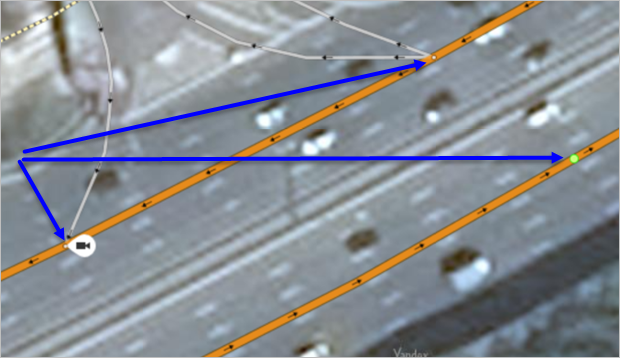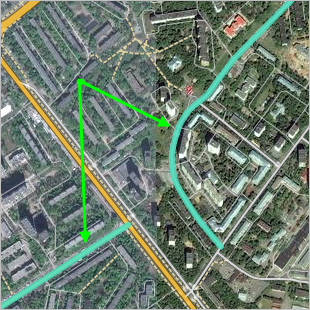3.3. Roads
Road
category items include:
- All motorways from highways of federal significance and international highways to driveways within courtyards and village roads.
- Bike and pedestrian paths.
Roads in Yandex Map Editor are composite linear items that are not drawn on the map, but rather compiled from sections of road, each of which is drawn individually and assigned attributes separately (for more information, see3.3.2. Attribution rules of sections).
There are two related components of the rules for drawing and adding attributes to road networks:
-
Rules for drawing and adding attributes to sections of road.
Road section — this is the smallest element of the road network. It may be either straight or curved and has a beginning and ending point.
The beginning and ending points of a road section are points where:
- Roads intersect (including those located at different levels, such as when a road on a bridge runs over another road or a road in a tunnel runs under another one)
- Roads intersect with other items (railways, rivers, etc.) or these intersections affect how the road network functions (such as at a railway crossing)
- The values of one of the characteristics (attributes) of the road section are changed (see Section 3.3.2. Attribution rules of sections).
For more information, see sections:
-
Rules for drawing and adding attributes to roads.
For more information, see sections:
Some road attributes (particularly name and class) are entered and edited when you add attributes to a road section. You can also edit the name later in the attribute panel for the road itself.
When drawing connecting road elements, the start and end points of each pair (or more) of road elements form objects Intersection. Intersections are created automatically in the process of rendering road segments (in the figure indicated with blue arrows):

Intersections let you make certain adjustments to the road network. For more information, see Section2.9. Intersections.
Additionally, road signs, traffic lights, and speed cameras may be linked to intersections.
Alert
Be careful when drawing roads. The road network is used to set routes, so drawing errors can lead to routing mistakes.
A road is usually a geometrically unified (connected) object. Of course, there are exceptions to this rule: there may be breaks in a road or a single road may consist of several sections that are separated from one another (although this separation is usually less than two kilometers in length).
For example, Flotskaya street in Moscow consists of two such sections (it is separated into sections by Onezhsky and Solnechnogorsky streets:

The road only includes sections that are officially components of that road. Passageways within courtyards, dead ends, or passageways between blocks in rural localities are officially not considered parts of roads and are not included in roads on maps.
Alert
When editing the road network, make sure that roads that have already been created on the map were not deleted. Other map items may be connected to roads (especially addresses), and these connections can get destroyed if you delete those roads.
So if the shape of a road is incorrect, you should edit the existing road section (rather than deleting it and starting over).